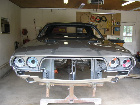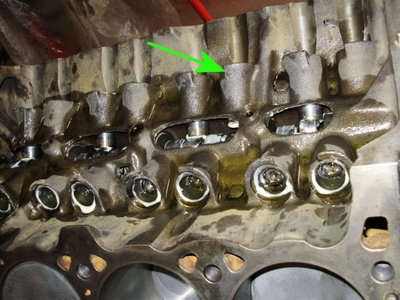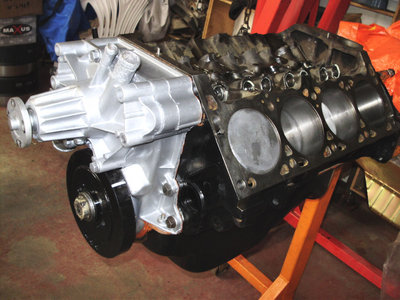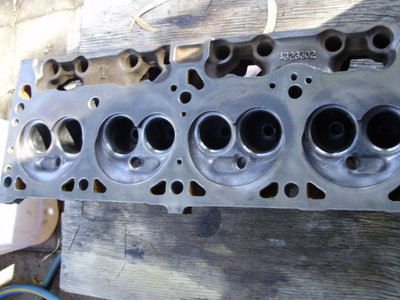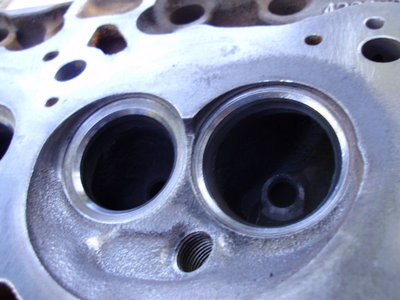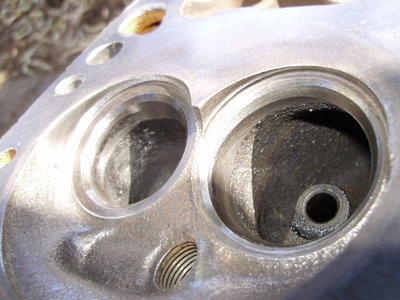25 posts
• Page 1 of 1
late 318 CR question
I pulled the 318 out of my 71 a few weeks ago. It was a replacement engine (factory assembled 1993) back when it was in Iowa, (or Idaho?).
Anyway, it has closed chamber heads -someone told me they were called "swirl chamber" heads. Normal cast flat top pistons. Does anyone here know approximately what CR these later 318's had? I think the older 318's ('73) with the open chamber heads had about 8.5:1. '71 engines had 8.8:1 .
thanks
Anyway, it has closed chamber heads -someone told me they were called "swirl chamber" heads. Normal cast flat top pistons. Does anyone here know approximately what CR these later 318's had? I think the older 318's ('73) with the open chamber heads had about 8.5:1. '71 engines had 8.8:1 .
thanks
-
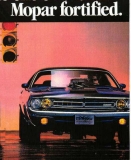
Goldenblack440 - Frequent Poster
- Posts: 600
- Joined: 08 Jul 2007 18:57
Those heads are THE best heads for a 318.
They were based on the heart shaped heads Chrysler experimented with in the 1969 Indy program and 1970-71 Trans Am effort. They used this design technology in the 2.2 4-cylinder production heads and then developed the 318 head from that in about 1986.
The reason i know this is from research i did into small block heads back in the late 80s when I had my Valiant Charger 770 with 318. Just before I found I could just about afford to import a 440 Challenger instead.
Fitted with 1.88 intake and 1.60 exhaust valves and ported for max velocity rather than volume they seriously out performed hogged out 360 heads with 2.02 inch intakes, producing over 40hp more.
In April 1988 Hot Rod magazine used these heads to build a 9:1 compression 318 that made 331hp with only a 0.455-inch lift MP cam.
They were based on the heart shaped heads Chrysler experimented with in the 1969 Indy program and 1970-71 Trans Am effort. They used this design technology in the 2.2 4-cylinder production heads and then developed the 318 head from that in about 1986.
The reason i know this is from research i did into small block heads back in the late 80s when I had my Valiant Charger 770 with 318. Just before I found I could just about afford to import a 440 Challenger instead.

Fitted with 1.88 intake and 1.60 exhaust valves and ported for max velocity rather than volume they seriously out performed hogged out 360 heads with 2.02 inch intakes, producing over 40hp more.
In April 1988 Hot Rod magazine used these heads to build a 9:1 compression 318 that made 331hp with only a 0.455-inch lift MP cam.
-
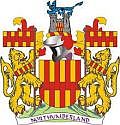
dave-r - Grumpy Old Man
- Posts: 9842
- Joined: 12 Oct 2003 21:45
- Location: North of the Tyne, England
Thankyou very much for all that good info ! Didn't know they were so good. My mechanic and i are doing a good quality re-ring/rebuild on this engine to sell and split the proceeds. So it seems a bit of a pity just to sell it, as almost all aussies wouldn't know one head from another -its just another 318 they think they can get for next to nothing. So this will make me think. The cam we are using is a MP 340 grind and the valve lift is actually very close to 0.45.
As for the Magnums -not sure when they came out -this engine (the block) has a cast date of 1984, no date stamp on the heads. However, on the back of the block, next to the cam plug was written a date in 93 -the same date also written on the back of one head in white enamal. The engine had also obviously never been pulled down.
As for the Magnums -not sure when they came out -this engine (the block) has a cast date of 1984, no date stamp on the heads. However, on the back of the block, next to the cam plug was written a date in 93 -the same date also written on the back of one head in white enamal. The engine had also obviously never been pulled down.
-

Goldenblack440 - Frequent Poster
- Posts: 600
- Joined: 08 Jul 2007 18:57
A version of this engine was available until 1991 when its was superseded by the Magnum version
http://en.wikipedia.org/wiki/Chrysler_LA_engine
http://en.wikipedia.org/wiki/Chrysler_LA_engine
-

dave-r - Grumpy Old Man
- Posts: 9842
- Joined: 12 Oct 2003 21:45
- Location: North of the Tyne, England
Interesting info there on that link. According to the same source..."The 318 received roller lifters and a fast-burn cylinder head in 1985, and throttle-body electronic fuel injection for truck applications starting in 1988."
Also, "The Magnum 5.2, released in 1992, was an evolutionary development of the 318 with the same displacement. The Magnum development included the multiport fuel injection, new cylinder heads with a closed combustion chamber, a new higher-flow valve angle, increased valve lift, and new intake and exhaust manifolds."
So i am wondering if these heads i have are Magnum heads. Except it didn't have roller lifters. If not them, perhaps they are the 'fast burn' type mentioned above. And i know the Magnum inlet won't bolt on to the old heads and vice versa. This engine has a standard 2bbl with factory Holley.
Also, "The Magnum 5.2, released in 1992, was an evolutionary development of the 318 with the same displacement. The Magnum development included the multiport fuel injection, new cylinder heads with a closed combustion chamber, a new higher-flow valve angle, increased valve lift, and new intake and exhaust manifolds."
So i am wondering if these heads i have are Magnum heads. Except it didn't have roller lifters. If not them, perhaps they are the 'fast burn' type mentioned above. And i know the Magnum inlet won't bolt on to the old heads and vice versa. This engine has a standard 2bbl with factory Holley.
-

Goldenblack440 - Frequent Poster
- Posts: 600
- Joined: 08 Jul 2007 18:57
burdar wrote:You would easily be able to tell if it was a magnum engine. The intake manifold bolts are straight up and down on a magnum engine...they don't go in at an angle like the old design.
yeah, i saw a really cheap inlet on EBay, from KMJ Performance, it has provision to be able to be bolted to both early LA and the later Magnum engines. Its only $149, made in China of course but it looks to be a copy of a Weiand Stealth. It is dual plane and has an airgap at the front. It is supplied with what look like aluminium plugs to plug into the holes that arn't used.
I think i put the link to it somewhere here for Jon. For that price its tempting.
-

Goldenblack440 - Frequent Poster
- Posts: 600
- Joined: 08 Jul 2007 18:57
When all else fails. The LA heads are shaft mounted rockers. The maggies all use a pedastel mount rocker kinda similar to the ford/shivy setups but with a roller trunion instead of a ball socket. As for aftermarket rocker setups the Magnum heads uses standard Chevy ped. mount roller rockers. The shaft rockers are superior in strength and simplicity. Both need mods for above .550 lift cams,(springs, retainers and spring seats and guides). Stock Vs. Stock-The Magnum Heads are superior for performance and economy due to the lighter valve train and flow balance of the mag heads. The torque curve is less peaky and is a longer flatter curve. The mag engines make superior torque than the LA heads, blah blah  BTW, Ive never used the offshore dual plane airgap,,but I have an Edlebrock AG on my 5.9 Maggie plant in my truck,,it works great! The intake port alignment has been an issue on the 'lowcost' intake from the MoPar boards Ive seen posted.
BTW, Ive never used the offshore dual plane airgap,,but I have an Edlebrock AG on my 5.9 Maggie plant in my truck,,it works great! The intake port alignment has been an issue on the 'lowcost' intake from the MoPar boards Ive seen posted.
-

Eddie - Frequent Poster
- Posts: 6212
- Joined: 16 Oct 2006 21:26
- Location: Terre Haute, Ind.
burdar wrote:The best factory LA style 318 heads are the 302's. That is the last three numbers of the part number I think. I assume those are the ones you have.
What year did they switch to the Magnum heads? I thought that was before 93.
I think they went to the Magnum in 1989. Could be wrong though.
I checked the part number -yes they are 4323302 (yay!). I have already put new 360 springs on and i will give the valves a lap in. Before i reassemble them, i will do a very mild cleanup with the die grinder. And a port match. It won't cost anything except time and will give the buyer less reason to try and knock me down in price. I wonder if it would be worthwhile putting on 360 exhaust manifolds father than the smaller 318 ones?
-

Goldenblack440 - Frequent Poster
- Posts: 600
- Joined: 08 Jul 2007 18:57
airfuelEddie wrote:When all else fails. The LA heads are shaft mounted rockers. The maggies all use a pedastel mount rocker kinda similar to the ford/shivy setups but with a roller trunion instead of a ball socket. As for aftermarket rocker setups the Magnum heads uses standard Chevy ped. mount roller rockers. The shaft rockers are superior in strength and simplicity.
i wonder why they went to that inferior design Ed?
Were they lighter? Although i can't see how. Wonder if it was something to do with the pushrod location -getting a better flowing port design?
-

Goldenblack440 - Frequent Poster
- Posts: 600
- Joined: 08 Jul 2007 18:57
Beats the hell outta me Steve! I always liked the shaft rocker design of the MoPar's V-8 and even the "leaning Tower of Power's Six! The Magnums advantage is the dual quench closed combustion chambers, lighter valvetrain, better flowing and better flow balance between the ports, high velocity airflow with a very skiny intake pushrod pinch point that necks down to .880 1/2" into the intake ports, this gives a 'venturi' effect on the airflow and speeds it up somewhat. They are good for torque at low speeds. No Heat crossover,, they are notorious for cracked exhaust seats after only 50,000 miles!! 50% will be bad!! They flow around 200-210 CFM Intake and 160 Ex. Stock,, Perfect Truck Engine! A Better Head for Higher performance levels are the Indy 360-1 and -2's(Square and Oval intake ports are the differences) or the old standyby W-2 or alloy W-5's but you can make an easy 425-450 HP with a 360 Magnum Engine, Stock Heads, and .500-.525 lift springs, Juice hyd. cam or small solid with 'conversion rockers' longer pushrods, stiffer springs,,blahblah,,so its not too bad a design,,just when you start getting up in lifts and stiffer competition valvesprings. Then you should use larger rocker studs and possibly a valvetrain girdle to tie it all together 
-

Eddie - Frequent Poster
- Posts: 6212
- Joined: 16 Oct 2006 21:26
- Location: Terre Haute, Ind.
wow, thanks for all the good low-down on that. I would like to think that Chrysler in their wisdom would only change a good existing fundamental design if it was well worth doing it. And it sounds like it was, although the teething troubles (burnt ex seats) sounds like a rather fundamental problem! The very fast velocity ports would be great for streetability, but what about at the high revs when you need a lot more flow volume? You shouldn't have to change heads to achieve that. Then again, i suppose when they designed them in these fuel-frugal times, they were not thinking performance like us, more of a more efficient all-rounder.
-

Goldenblack440 - Frequent Poster
- Posts: 600
- Joined: 08 Jul 2007 18:57
Gotta remember some things about those heads, they were designed for Multi-Point Fuel Injected Truck Engines. The fuel was already atomised at 45 psi before it gets squirted behind the warm intake valve and high velocity airflow aided combustion efficiency with the well designed combustion chambers. The beer barrel manifold has very long tapered swept or tucked runners designed for velocity and intake charge.They can make 410-430 HP stock with a single plane intake and hyd. cam just like their crate engines in the 5.9 Magnum size they used to sell it was stock truck engine with the cam and intake, headers, ect very simple.For above .600 lift I would use a shaft mounted offset intake port head like the Indy or W series MoPar heads. Those heads have much larger intake ports with the requisite volume to make "big power" at much higher RPM's and they have a 'positive' valvetrain but are meant to be used with 48 degree lifter bores and for that the block must change. Hell, I wouldnt use a stock MoPar smallblock for anything over 550 HP anyways. The lifter valley and cylinder bores become an issue. The siamese bore 340 'resto' block is capable however, it has an .180 over bore capability. This has gotten WAY offtopic sorry.Goldenblack440 wrote:wow, thanks for all the good low-down on that. I would like to think that Chrysler in their wisdom would only change a good existing fundamental design if it was well worth doing it. And it sounds like it was, although the teething troubles (burnt ex seats) sounds like a rather fundamental problem! The very fast velocity ports would be great for streetability, but what about at the high revs when you need a lot more flow volume? You shouldn't have to change heads to achieve that. Then again, i suppose when they designed them in these fuel-frugal times, they were not thinking performance like us, more of a more efficient all-rounder.
-

Eddie - Frequent Poster
- Posts: 6212
- Joined: 16 Oct 2006 21:26
- Location: Terre Haute, Ind.
Very knowlegable answers there, thanks. Since we never got the Magnum engine down here, there is very little known about it. The fuel injection part makes sense (my brain is still always thinking carbs). Also on the lifter bores which you mentioned, my mechanic pointed out that the lifter bores on this 318 were much higher (longer) than any others he we had seen (see pics)
But back to my original question, would you perhaps be able to take a guess at what the CR might be for this engine? Could it be as high as 10:1 ? I have posted some pictures of the combustion chamber. You can also see how perfect the valve seats were. There was zero wear in the valve guides and as i said it was almost like new inside -except it blew heaps of smoke -the rings were weak and the bores were glazed.
But back to my original question, would you perhaps be able to take a guess at what the CR might be for this engine? Could it be as high as 10:1 ? I have posted some pictures of the combustion chamber. You can also see how perfect the valve seats were. There was zero wear in the valve guides and as i said it was almost like new inside -except it blew heaps of smoke -the rings were weak and the bores were glazed.
-

Goldenblack440 - Frequent Poster
- Posts: 600
- Joined: 08 Jul 2007 18:57
Those are stock 59 degree lifter bores which are designed for hyd. roller's and the retainer plate and lifter locks that 'sit' on top of the lifters and lifter bosses to prevent the lifter body from rotating inside the lifter bore.The lifter bores are taller for the hydraulic roller's longer body much taller lifters than the flat tappet's lifters. Some blocks were cast to accomodate the spider spring steel plate which is attached with the threaded bosses in the middle of the lifter valley,(3). You can use either hyd. roller or flat tappet cam with that block. The Comp. Ratio should be a spec 8.8 to one,(Approx.) ( the Magnums were 9:1 but used different pistons and had a diff. Comp. Height), with swirl port heads as those are. With carbs you are gonna have to keep in mind the ratio increases as the engine ages due to carbon deposits, not so much with fuel injection. You can quickly calculate the comp ratio with any ' engine building sites calculators if you know how much the piston is in the hole? Then the thickness of a stock OEM gasket or the gasket you are gonna use? One way to induce turbulence in any wedge head is to purposely shroud the valves with either the cylinder diameter or the chamber as it pertains to the valve sides near the chamber edge.
-

Eddie - Frequent Poster
- Posts: 6212
- Joined: 16 Oct 2006 21:26
- Location: Terre Haute, Ind.
Wow, that's interesting -so this was cast ready for hydraulic roller lifter and it has those 3 lifter valley threaded holes. Does that mean it could be classified as a Magnum block?
As for the CR, i don't think it would only be 8.8:1. The 71 manual for 318 is 8.8 and thats with the open chamber heads. I will have to check the piston height in the bore, but i would assume that the closed chamber heads would bump up the CR at least almost a full point.
I know a static compression test can be misleading, however when i did a comp test with the old worn out stock cam, i got massive readings such as over 210psi in all cylinders. Putting in a mild cam with more duration brought that down to a still-high 180+ psi. I'm sure the head design also played a part in that.
As for the CR, i don't think it would only be 8.8:1. The 71 manual for 318 is 8.8 and thats with the open chamber heads. I will have to check the piston height in the bore, but i would assume that the closed chamber heads would bump up the CR at least almost a full point.
I know a static compression test can be misleading, however when i did a comp test with the old worn out stock cam, i got massive readings such as over 210psi in all cylinders. Putting in a mild cam with more duration brought that down to a still-high 180+ psi. I'm sure the head design also played a part in that.
-

Goldenblack440 - Frequent Poster
- Posts: 600
- Joined: 08 Jul 2007 18:57
The pre-Magnum blocks had roller lifters in them with shaft mounted rockers,,this was the 1st step (1985 with 318's) followed by 360's in 1989. This was carried over when they went to the Magnum design 5.2/5.9,,Magnum heads are the same for both 5.2/5.9 engines. The piston weights dropped a bit and they had dished designs with 1/16 ringpack. They were 'spec' at 9:0 to 1 I think your's is a bit lower than the Magnums. But to be sure just measure the psiton at TDC and see what the comp height is, followed by gasket thickness, CC the chambers. Plug all that data in to an engine building calculator. I like Keith Blacks site. 
-

Eddie - Frequent Poster
- Posts: 6212
- Joined: 16 Oct 2006 21:26
- Location: Terre Haute, Ind.
-

Goldenblack440 - Frequent Poster
- Posts: 600
- Joined: 08 Jul 2007 18:57
Goldenblack. Here is a tip.
Get that grease off those lifters and lifter bores.
Put grease on the cam lobes and lifter base ONLY.
The lifter sides and bore should be clean and just oiled with a light engine oil.
This is particulaly important if the cam and lifters need breaking in. Check that the lifters spin freely by hand and if lifted by hand they should drop easily back onto the cam under their own weight.
Get that grease off those lifters and lifter bores.
Put grease on the cam lobes and lifter base ONLY.
The lifter sides and bore should be clean and just oiled with a light engine oil.
This is particulaly important if the cam and lifters need breaking in. Check that the lifters spin freely by hand and if lifted by hand they should drop easily back onto the cam under their own weight.
-

dave-r - Grumpy Old Man
- Posts: 9842
- Joined: 12 Oct 2003 21:45
- Location: North of the Tyne, England
OK, thanks for the tip. Although the cam is a good used one and doesn't need breaking in, and the lifters are from that cam, kept in order. My mechanic built that bottom end (i'm doing the heads) and he does that with the pistons -ie, everything above the rings (and bore) is kept dry and a light oil of the skirts. As in a healthy engine, no oil should come up past the rings anyway. This is what ring manufacturers are recommending, contrary to what the engine building books of old used to say, ie, dip the whole piston a can of engine oil and install dripping wet. After years of glazed bores from doing this, it is now best to install the pistons "dry". I assume this is the general idea you are talking about with the lifter grease.
Also Back onto the subject of the CR for this engine, some people have said to measure the amount the piston is in the bore at TDC. Well, i havn't got around to this yet, but looking at the picture i posted, the piston looks rather level with the deck, so i don't think this would be a 8.8 engine with the closed chamber heads. A a data check will tell though
Also Back onto the subject of the CR for this engine, some people have said to measure the amount the piston is in the bore at TDC. Well, i havn't got around to this yet, but looking at the picture i posted, the piston looks rather level with the deck, so i don't think this would be a 8.8 engine with the closed chamber heads. A a data check will tell though
-

Goldenblack440 - Frequent Poster
- Posts: 600
- Joined: 08 Jul 2007 18:57
-

dave-r - Grumpy Old Man
- Posts: 9842
- Joined: 12 Oct 2003 21:45
- Location: North of the Tyne, England
Good info with this thread.  As outdated as it may be, my upbringing taught a cam and lifters go together for life.
As outdated as it may be, my upbringing taught a cam and lifters go together for life.  Different hardening and wear patterns on the lobe and lifter face. As for piston rings, swab the bore and burn off the excess. The only problem I have had were trying Chrome rings, once.
Different hardening and wear patterns on the lobe and lifter face. As for piston rings, swab the bore and burn off the excess. The only problem I have had were trying Chrome rings, once. 
 As outdated as it may be, my upbringing taught a cam and lifters go together for life.
As outdated as it may be, my upbringing taught a cam and lifters go together for life. 
-
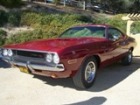
Jon - Frequent Poster
- Posts: 1229
- Joined: 21 Aug 2005 15:12
- Location: Medford Oregon
yes, that's what i was led to believe -but my mechanic has some funny ideas (not all of which i agree with), including his idea that you can swap and change lifters every which way (as long as the bases are not worn or damaged/pitted) with any cam and they will be ok with some sticky cam lube (!) Then others say that that is the quickest way to wipe a lobe. But he reckons he has never had any problem. As for the chrome rings, are you talking about chrome-moly? as that is all that seems to be available now - Summit have them very cheap ($40-60)
-

Goldenblack440 - Frequent Poster
- Posts: 600
- Joined: 08 Jul 2007 18:57
25 posts
• Page 1 of 1
